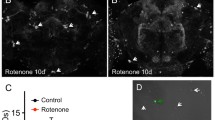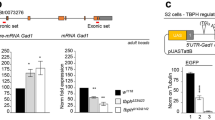Abstract
Impairment of the dopamine system is the main cause of Parkinson disease (PD). PTEN-induced kinase 1 (PINK1) is possibly involved in pathogenesis of PD. However, its role in dopaminergic neurons has not been fully established yet. In the present investigation, we have used the PINK1 knockout Drosophila model to explore the role of PINK1 in dopaminergic neurons. Electrophysiological and behavioral tests indicated that PINK1 elimination enhances the neural transmission from the presynaptic part of dopaminergic neurons in the protocerebral posterior medial region 3 (PPM3) to PPM3 neurons (which are homologous to those in the substantia nigra in humans). Firing properties of the action potential in PPM3 neurons were also altered in the PINK1 knockout genotypes. Abnormal motor ability was also observed in these PINK1 knockout animals. Our results indicate that knockout of PINK1 could alter both the input and output properties of PPM3 neurons.





Similar content being viewed by others
References
Aarsland D, Creese B, Politis M, Chaudhuri KR, Ffytche DH et al (2017) Cognitive decline in Parkinson disease. Nat Rev Neurol 13:217–231
Aso Y, Hattori D, Yu Y, Johnston RM, Iyer NA et al (2014) The neuronal architecture of the mushroom body provides a logic for associative learning. eLife 3:e04577
Barone MC, Bohmann D (2013) Assessing neurodegenerative phenotypes in Drosophila dopaminergic neurons by climbing assays and whole brain immunostaining. J Vis Exp 74:e50339
Cackovic J, Gutierrez-Luke S, Call GB, Juba A, O’Brien S et al (2018) Vulnerable Parkin loss-of-function drosophila dopaminergic neurons have advanced mitochondrial aging, mitochondrial network loss and transiently reduced autophagosome recruitment. Front Cell Neurosci 12:39
Clark IE, Dodson MW, Jiang CG, Cao JH, Huh JR et al (2006) Drosophila pink1 is required for mitochondrial function and interacts genetically with parkin. Nature 441:1162–1166
Dickson DW, Braak H, Duda JE, Duyckaerts C, Gasser T et al (2009) Neuropathological assessment of Parkinson’s disease: refining the diagnostic criteria. Lancet Neurol 8:1150–1157
Exner N, Lutz AK, Haass C, Winklhofer KF (2012) Mitochondrial dysfunction in Parkinson’s disease: molecular mechanisms and pathophysiological consequences. EMBO J 31:3038–3062
Fricker D, Miles R (2000) EPSP amplification and the precision of spike timing in hippocampal neurons. Neuron 28:559–569
Gautier CA, Kitada T, Shen J (2008) Loss of PINK1 causes mitochondrial functional defects and increased sensitivity to oxidative stress. Proc Natl Acad Sci USA 105:11364–11369
Gouwens NW, Wilson RI (2009) Signal propagation in Drosophila central neurons. J Neurosci Off J Soc Neurosci 29:6239–6249
Gu HY, O’Dowd DK (2006) Cholinergic synaptic transmission in adult Drosophila kenyon cells in situ. J Neurosci 26:265–272
Guo M (2012) Drosophila as a model to study mitochondrial dysfunction in Parkinson’s disease. Csh Perspect Med 2:a009944
Julienne H, Buhl E, Leslie DS, Hodge JJL (2017) Drosophila PINK1 and parkin loss-of-function mutants display a range of non-motor Parkinson’s disease phenotypes. Neurobiol Dis 104:15–23
Kitada T, Pisani A, Porter DR, Yamaguchi H, Tscherter A et al (2007) Impaired dopamine release and synaptic plasticity in the striatum of PINK1-deficient mice. Proc Natl Acad Sci USA 104:11441–11446
Kong EC, Woo K, Li H, Lebestky T, Mayer N et al (2010) A pair of dopamine neurons target the D1-like dopamine receptor DopR in the central complex to promote ethanol-stimulated locomotion in Drosophila. PLoS ONE 5:9954
Lang AE, Espay AJ (2018) Disease modification in Parkinson’s disease: current approaches, challenges, and future considerations. Mov Disord 33:660–677
Lee KS, Huh S, Lee S, Wu ZH, Kim AK et al (2018) Altered ER-mitochondria contact impacts mitochondria calcium homeostasis and contributes to neurodegeneration in vivo in disease models. Proc Natl Acad Sci USA 115:E8844–E8853
Madeo G, Schirinzi T, Maltese M, Martella G, Rapino C et al (2016) Dopamine-dependent CB1 receptor dysfunction at corticostriatal synapses in homozygous PINK1 knockout mice. Neuropharmacology 101:460–470
Mao Z, Davis RL (2009) Eight different types of dopaminergic neurons innervate the Drosophila mushroom body neuropil: anatomical and physiological heterogeneity. Front Neural Circuits 3:5
Massano J, Bhatia KP (2012) Clinical approach to parkinson’s disease: features, diagnosis, and principles of management. Csh Perspect Med 2:a008870
Matsuda S, Kitagishi Y, Kobayashi M (2013) Function and characteristics of PINK1 in mitochondria. Oxid Med Cell Longev 2013:601587
Michel PP, Hirsch EC, Hunot S (2016) Understanding dopaminergic cell death pathways in Parkinson disease. Neuron 90:675–691
Midorikawa M, Sakaba T (2017) Kinetics of releasable synaptic vesicles and their plastic changes at hippocampal mossy fiber synapses. Neuron 96(1033–1040):e1033
Mouton-Ligeri F, Jacoupy M, Corvol JC, Corti O (2017) PINK1/Parkin-dependent mitochondrial surveillance: from pleiotropy to Parkinson’s disease. Front Mol Neurosci 10:120
Nissim TBK, Zhang XX, Elazar A, Roy S, Stolwijk JA et al (2017) Mitochondria control store-operated Ca2 + entry through Na + and redox signals. EMBO J 36:797–815
Nita I, Hershfinkel M, Fishman D, Ozeri E, Rutter GA et al (2012) The mitochondrial Na +/Ca2 + exchanger upregulates glucose dependent Ca2 + signalling linked to insulin secretion. PLoS ONE 7:e46649
Nita II, Hershfinkel M, Lewis EC, Sekler I (2015) A crosstalk between Na + channels, Na +/K + pump and mitochondrial Na + transporters controls glucose-dependent cytosolic and mitochondrial Na + signals. Cell Calcium 57:69–75
Otani S, Daniel H, Roisin MP, Crepel F (2003) Dopaminergic modulation of long-term synaptic plasticity in rat prefrontal neurons. Cereb Cortex 13:1251–1256
Parker WD, Parks JK, Swerdlow RH (2008) Complex I deficiency in Parkinson’s disease frontal cortex. Brain Res 1189:215–218
Pfeiffer K, Homberg U (2014) Organization and functional roles of the central complex in the insect brain. Annu Rev Entomol 59:165-U787
Pickrell AM, Youle RJ (2015) The roles of PINK1, Parkin, and mitochondrial fidelity in Parkinson’s disease. Neuron 85:257–273
Poewe W, Seppi K, Tanner CM, Halliday GM, Brundin P et al (2017) Parkinson disease. Nat Rev Dis Prim 3:1–21
Qiao J, Zou X, Lai D, Yan Y, Wang Q et al (2014) Azadirachtin blocks the calcium channel and modulates the cholinergic miniature synaptic current in the central nervous system of Drosophila. Pest Manag Sci 70:1041–1047
Rodriguez-Oroz MC, Jahanshahi M, Krack P, Litvan I, Macias R et al (2009) Initial clinical manifestations of Parkinson’s disease: features and pathophysiological mechanisms. Lancet Neurol 8:1128–1139
Schapira AH, Cooper JM, Dexter D, Jenner P, Clark JB et al (1989) Mitochondrial complex I deficiency in Parkinson’s disease. Lancet 1:1269
Spruston N, Jaffe DB, Williams SH, Johnston D (1993) Voltage- and space-clamp errors associated with the measurement of electronically remote synaptic events. J Neurophysiol 70:781–802
Strausfeld NJ, Hirth F (2013) Deep homology of arthropod central complex and vertebrate basal ganglia. Science 340:157–161
Villeneuve LM, Purnell PR, Boska MD, Fox HS (2016) Early expression of Parkinson’s disease-related mitochondrial abnormalities in PINK1 knockout rats. Mol Neurobiol 53:171–186
Wang HL, Chou AH, Wu AS, Chen SY, Weng YH et al (2011) PARK6 PINK1 mutants are defective in maintaining mitochondrial membrane potential and inhibiting ROS formation of substantia nigra dopaminergic neurons. Biochim Biophys Acta 1812:674–684
Zhu GQ, Liu Y, Wang YB, Bi XN, Baudry M (2015) Different patterns of electrical activity lead to long-term potentiation by activating different intracellular pathways. J Neurosci 35:621–633
Acknowledgements
This study was supported by National Nature Science Foundation of China, Grant Number: 81701414.
Author information
Authors and Affiliations
Corresponding author
Ethics declarations
Conflict of interest
None.
Additional information
Publisher's Note
Springer Nature remains neutral with regard to jurisdictional claims in published maps and institutional affiliations.
Electronic supplementary material
Below is the link to the electronic supplementary material.
Rights and permissions
About this article
Cite this article
Qiao, JD., Mao, YL. Knockout of PINK1 altered the neural connectivity of Drosophila dopamine PPM3 neurons at input and output sites. Invert Neurosci 20, 11 (2020). https://doi.org/10.1007/s10158-020-00244-4
Received:
Accepted:
Published:
DOI: https://doi.org/10.1007/s10158-020-00244-4




